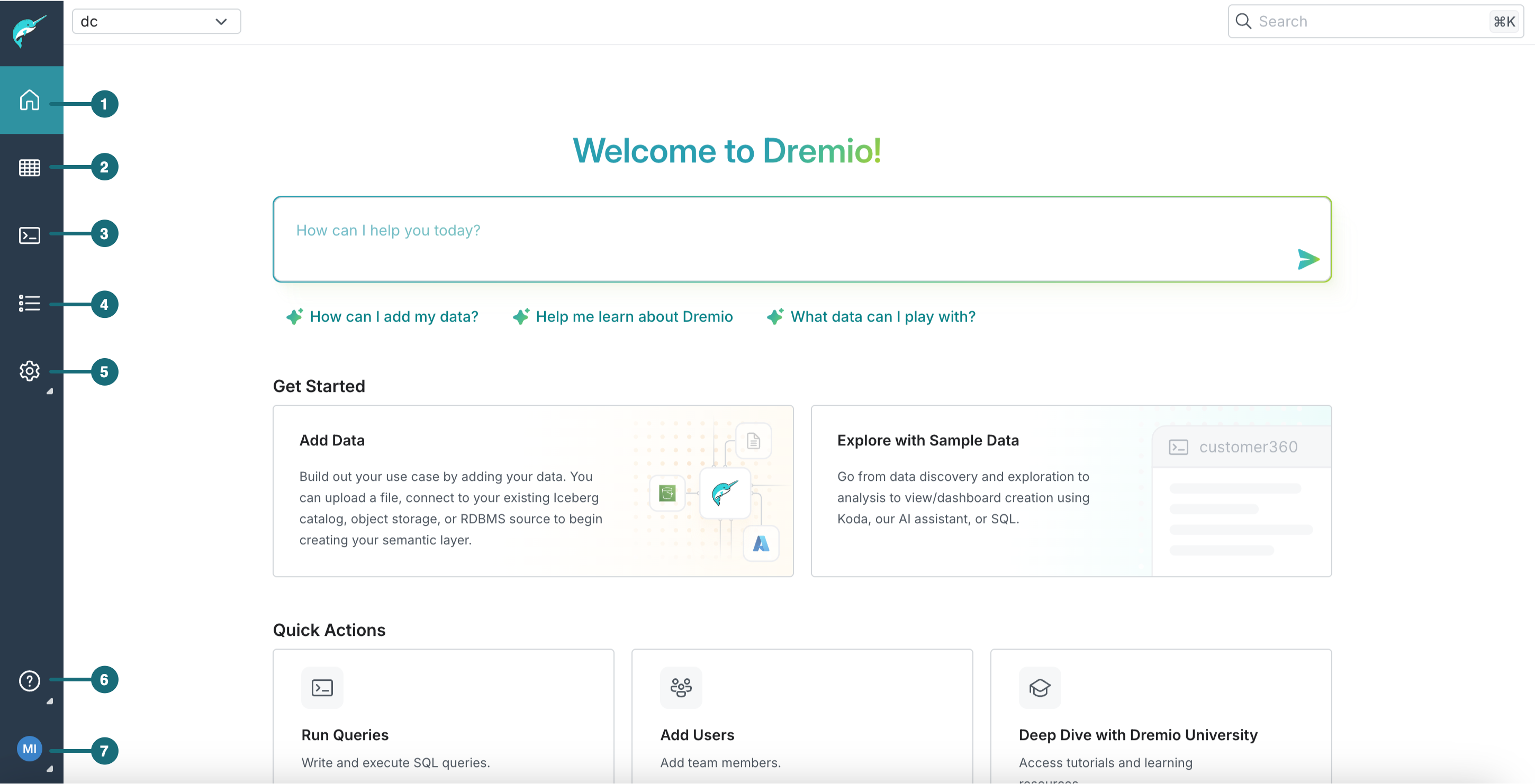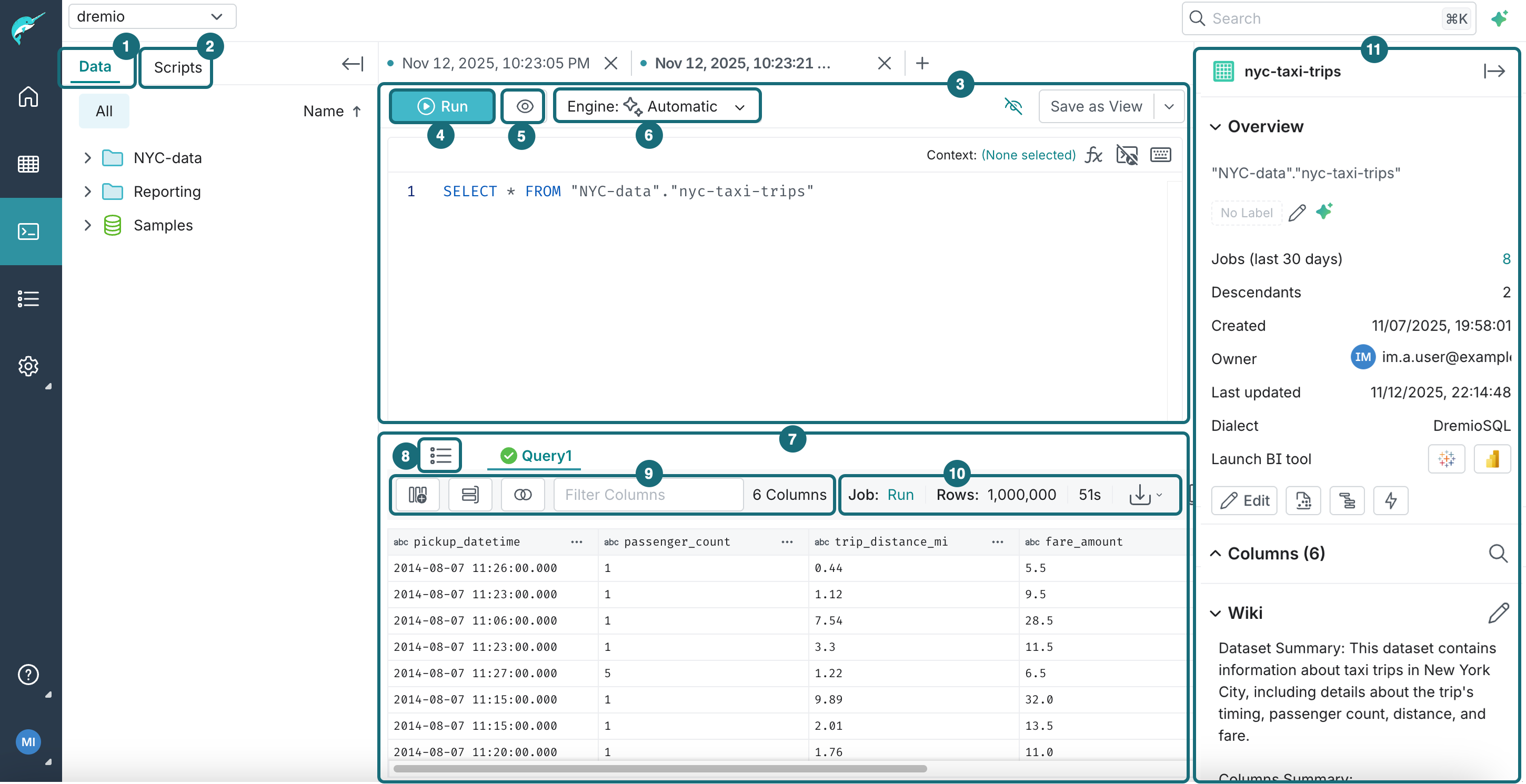Quick Tour of the Dremio Console
This quick tour introduces you to the main areas of the Dremio console, including the homepage, Datasets, SQL Runner, and Jobs pages. You'll learn how to navigate the interface and access key features of your agentic lakehouse.
Console Navigation
The side navigation bar provides links to key areas of the Dremio console.

| Location | Description |
|---|---|
| 1 | Homepage: Central landing page when you log in. |
| 2 | Datasets: Interface for exploring tables and views across the default Open Catalog, other catalogs, object storage, and database sources. |
| 3 | SQL Runner: Editor for constructing and querying data. |
| 4 | Jobs: History of executed SQL and job details. |
| 5 | Project and Organization Settings: Configuration for your catalog, engines, and routing rules in your project and management of authentication, users, billing, and projects in your organization. |
| 6 | Documentation and Support: Access point for documentation, the Community Forum, or the Support Portal. |
| 7 | Account Settings: Section for managing general information, personal access tokens, appearance preferences, and logout options. |
Datasets Page
The Datasets page provides navigation and management for data in your Open Catalog, other catalogs, object stores, and databases.

| Location | Description |
|---|---|
| 1 | Project Name: Name of the current project being explored. |
| 2 | Namespaces: Logical containers that organize data objects within Dremio's Open Catalog, providing hierarchical organization and access control for tables, views, and folders. |
| 3 | Sources: Self-hosted catalogs, object stores, or databases. |
| 4 | Path: Dot-separated identifier indicating the location of the object, starting with the source or catalog name, followed by any folders, and ending with the name of table or view. |
SQL Runner
The SQL Runner provides a query editor for running SQL. Access via ![]() in the side navigation bar.
in the side navigation bar.

| Location | Description |
|---|---|
| 1 | Data Panel: Area for exploring data across your Open Catalog, other catalogs, object stores, and databases, with drag-and-drop support for adding objects into the SQL editor. |
| 2 | Scripts Panel: Panel for saved SQL scripts that can be reused and shared with other users in your organization. Each script includes creation/modification timestamps and editor context and requires VIEW privileges. |
| 3 | SQL Editor: Workspace for creating and editing SQL with autocomplete, syntax highlighting, and function lookup. See SQL Reference for supported SQL. You may also highlight SQL, right-click, and select Explain SQL to start a chat with the AI Agent, which features a summary of the query’s overview, datasets, and architecture. For more details, see Explain SQL. |
| 4 | Run: Execution of the SQL, which returns the complete result set. |
| 5 | Preview: Option for previewing the result set, which returns a subset of rows in less time than running the SQL. |
| 6 | Engine: Dropdown menu for selecting an engine for SQL execution. By default, Automatic is selected, which routes the query to the appropriate engine based on engine routing rules. For more details, see Manage Engines. |
| 7 | Results Panel: Table displaying the results of your query with options to download, copy, or edit values. |
| 8 | Job Summary: Tab showing the job status, query type, start time, duration, and job ID. |
| 9 | Transformations: Tools for applying transformations such as Add Column, Group By, Join, Filter, Convert Data Type, and Add Calculated Field that automatically update SQL. |
| 10 | Execution State: Indicator displaying the job status, record count, and execution time, with a link to view full job details. Includes options to download results as JSON, CSV, or Parquet files, or copy data to the clipboard. |
| 11 | Details Panel: Right-side panel for viewing and managing dataset metadata, including columns, ownership, searchable labels, and wiki content. |
Limitations and Considerations
Row Limit: COUNT(*) and SELECT query results are limited to one million rows and may be truncated based on thread distribution. When truncated, a warning appears. To obtain complete results, use JDBC or ODBC drivers.
CSV Download: CSV download is unavailable for result sets with complex data types (union, map, array). The download and copy results options can be enabled or disabled for a specific project by navigating to Project Settings > Preferences.